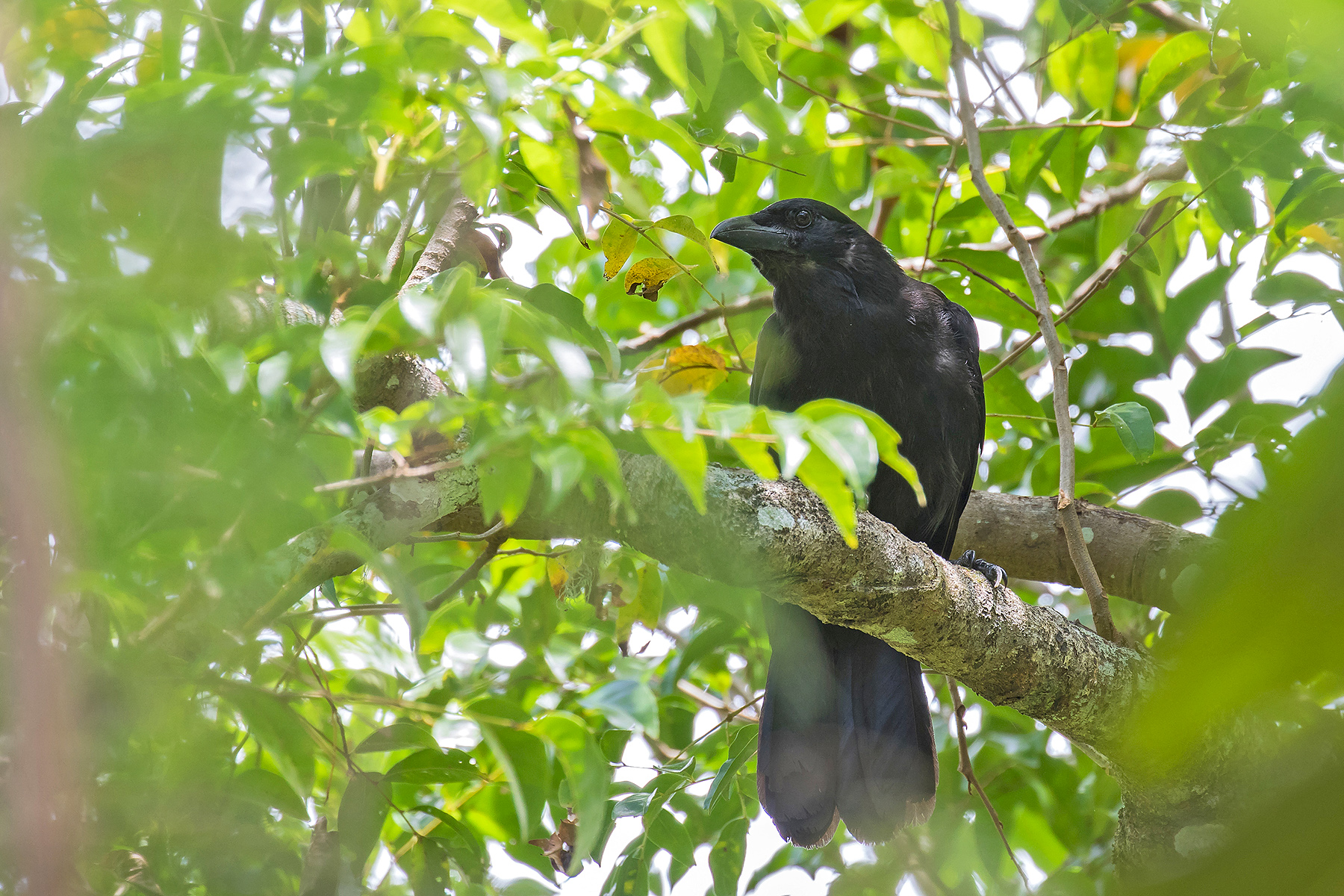MICRONESIA BIRDING TOUR: DETAILED ITINERARY
Micronesia: Day 1 The tour begins this evening at Koror in Palau, where we will stay for four nights.
(International flights into Koror arrive from Guam, Taipei, Manila and Tokyo.)
Micronesia: Days 2-4 The Republic of Palau (or Belau as it is known to its inhabitants) is the most western island group of Micronesia and is faunistically its richest part. The main town, on the island of Koror, is connected to the largest island, Babeldaob (or Babelthuap), by a bridge, while to the southwest is an archipelago of small islands, including the extraordinarily beautiful, strangely-shaped Rock Islands that emerge from the turquoise blue coral sea. The islands are thought to have been settled as long ago as 1000 BC, probably by people from what is now eastern Indonesia, but as with most places in Micronesia, Palau only really came to the attention of the outside world during World War II, when there were fierce battles for control of the heavily fortified southern islands of Angaur and Peleliu.
Our birding explorations in Palau will be divided between the Koror region and some of the outer islands only accessible by boat or air. On Koror and Babeldaob we will be looking for the endemic Palau Fruit Dove, the unusual Palau Owl, Palau Nightjar, Palau Swiftlet, Rusty-capped (or Palau) Kingfisher, Palau Cicadabird, Morningbird, Palau Bush Warbler (easily heard but harder to see), Mangrove (or Palau) Flycatcher, the smart Palau Fantail and Dusky White-eye. Further afield, we will explore the scenic outer islands in search of the Palau form of the Micronesian Megapode, Palau Ground Dove and the drab but impressive Giant White-eye. We also have a good chance of seeing the localized Nicobar Pigeon, a small-island specialist, the impressive, regionally-endemic Micronesian Imperial Pigeon, the regionally-endemic Citrine (or Caroline Islands) White-eye and, with a bit of luck, Tropical Shearwater.
Other species that we may well encounter during our stay in the islands include Little Pied Cormorant, Little Egret, Buff-banded Rail, White-browed and Slaty-legged Crakes, Greater Sand and Mongolian Plovers, Common Greenshank, Common Sandpiper, Black-headed Gull, Whiskered, Greater Crested, Black-naped and Bridled Terns, Collared Kingfisher, Barn Swallow and the introduced Red Junglefowl, Sulphur-crested Cockatoo, Eclectus Parrot and Chestnut Munia. The interesting local form of the White-breasted Woodswallow has become rare, but we will try our best to find it.
Micronesia: Day 5 Our flight to the island of Guam, a far-flung territory of the United States of America, leaves in the early hours of the morning. At Guam we will connect with a morning flight to Saipan for a two nights stay. After we have settled into our hotel, we will have the rest of the day to explore.
Micronesia: Day 6 Saipan is the largest island in the Northern Marianas, now a self-governing commonwealth territory of the USA, and has some 90% of the islands’ population. Saipan and adjacent Tinian saw fierce fighting towards the end of World War II, and nowadays many visitors are Japanese wanting to see something of this period in their history, or to enjoy the casinos! On Saipan, the Americans landed on 15 June 1944 at the southwest end of the island, and during the subsequent conquest, some 30,000 Japanese were killed as against 3,500 American troops (and some 400 Saipanese civilians). To this day the island is littered with pillboxes and bunkers constructed by the Japanese and there are some poignant memorials at the steep cliffs at the northern end of the island where hundreds of Japanese troops and civilians committed suicide rather than be captured.
From an ornithological viewpoint, Saipan is the richest island in the Marianas and here we shall be looking for such Marianas endemics as Mariana Fruit Dove, Mariana (or Guam) Swiftlet, Mariana (or White-headed) Kingfisher, the impressive Saipan Reed Warbler, Saipan Bridled White-eye and the beautiful Golden White-eye, as well as the smart, regionally-endemic White-throated Ground Dove (ludicrously easy to see here for a ground-dove, often flying high over the forest canopy and the roads!), the widespread endemic Micronesian Myzomela (or Micronesian Honeyeater) and Micronesian Starling. In addition, the endemic Marianas form of the Micronesian Megapode still survives here, and with persistence, we may well see one creeping about in the forest, apparently unconcerned by our presence.
Other species we are likely to encounter include White-tailed Tropicbird, Brown Booby, Yellow Bittern, Pacific Golden Plover, Brown Noddy, Common White (or Fairy) Tern, Rufous Fantail and the introduced Philippine Turtle Dove (or Island Collared Dove), Eurasian Tree Sparrow and Orange-cheeked Waxbill.
During our stay on Saipan, we will also make a short side-trip by air to the adjacent island of Tinian, the scene of another great battle in World War II and later used for bombing raids on Japan, including the world’s first and mercifully only nuclear strikes. As we approach the small airport on Tinian we will be able to see the deserted runways at North Field, from where the Enola Gay and its sister aircraft took off on those fateful missions to Hiroshima and Nagasaki. On Tinian, we will be looking for the endemic Tinian Monarch, which is still quite a common bird in the scrubby forest that covers much of the island.
Micronesia: Day 7 After some final birding on Saipan we will take an afternoon flight to the island of Rota for a two nights stay.
Micronesia: Day 8 Rota, which is about halfway between Guam and Saipan, largely escaped the bloody battles of World War II and this attractive island still has inhabitants who are full-blooded Chamorros, the earliest colonizers of the Marianas. Few visitors reach the island, which has a friendly, laid-back atmosphere. Our main targets here are the endangered endemic Mariana Crow, which still breeds successfully on Rota in spite of competition from the introduced Black Drongo (unlike Guam, the only other island on which it existed, where it is now extinct) and the critically endangered endemic Rota Bridled White-eye, for which we will have to visit the highland forest. Guam Rail (which is now considered extinct on Guam itself, owing to introduced snake predation) has been introduced here and we have a good chance of seeing this critically endangered species. Thankfully the endemic Rota Kingfisher, which may represent a species distinct from Mariana Kingfisher of Saipan and Tinian, is still a common bird.
We will also visit a spectacular seabird colony where large numbers of Red-footed Boobies nest in the forest canopy while Brown Boobies and lovely Red-tailed Tropicbirds nest on the steep cliffs. Great Frigatebirds regularly visit the colony to steal some fish from its occupants. Along the rocky coastline, Pacific Reef Egrets are regularly to be found.
Micronesia: Day 9 After some final birding on birding on Rota we will catch a flight to Guam for an overnight stay.
Guam’s avifauna has suffered a complete disaster in recent decades at the hands of introduced creatures; in particular the Brown Tree Snake. The endemic Guam Flycatcher and Guam Bridled White-eye are now extinct, having both been common in the 1970s, and the endemic Guam Rail is extinct in the wild (hence the Rota introduction scheme). The endemic Guam Kingfisher now only survives in captivity.
Micronesia: Day 10: Our flight to the island of Yap leaves in the early hours of the morning. We will spend the next four nights on Yap and will have plenty of time today for some initial exploration.
Micronesia: Days 11-13 Yap is the westernmost of the main islands of the Federated States of Micronesia and tradition still holds sway in many parts of the island. Traditional architecture survives in the villages and some men and women in country areas still dress in customary style. Yap is famous for its rai, or ‘stone money’, a tradition whereby huge stone disks of up to 3.6 metres (12 feet) in diameter were carved from the Rock Islands of Palau and then transported on rafts towed by canoes more than 400 kilometres (240 miles) to Yap. Many Yapese were lost at sea in the attempt to transport these immense ‘coins’, which served to make the surviving ‘money’ even more valuable! To this day, rai is still used for some traditional transactions.
The rolling green hills of interior Yap hold some good areas of forest and it is here that we will be searching for the island’s four single-island endemics, which comprise the uncommon Yap Cicadabird, the smart Yap Monarch, Plain White-eye and the localized Olive White-eye (or Yap Olive or Olive-coloured White-eye). The local form of the regionally-endemic White-throated Ground Dove has sometimes been split as White-headed Ground Dove. Micronesian Imperial Pigeon is easy to see here, unlike in Palau, while Scaly-breasted Munia (or Nutmeg Mannikin) is a widespread introduction and small wetlands attract migrant Tufted Ducks.
There may well be enough time to fit in some sightseeing on Yap. The island is famous for its scuba diving and snorkelling on the wonderful coral reefs and you can even see huge Manta Rays as well as many colourful reef fish while snorkelling. It is easy to arrange a snorkelling (or diving) trip through our hotel, which is also the island’s premier dive centre.
Micronesia: Day 14 After another early hours flight back to Guam we will take a connecting flight far to the southeast of Guam, to the islands of Truk (or Chuuk) for a three nights stay.
Micronesia: Days 15-16 Truk, or Chuuk as it is nowadays officially called, is part of the Federated States of Micronesia. Infrequent air schedules mean that we will probably have more than enough time here, but there are worst places to be than a lagoon full of tropical islands!
The airport and most of the infrastructure are on the island of Weno (or Moen), where we will be looking in particular for the beautiful White-fronted (or Caroline Islands) Ground-Dove and Purple-capped Fruit Dove (both shared only with Pohnpei) and the endemic Oceanic Flycatcher. We can also expect to see the more widespread, regionally-endemic Caroline Islands Swiftlet and Caroline Islands Reed Warbler for the first time (plus the Caroline form of Citrine White-eye), as well as the more widespread Blue-faced Parrotfinch.
We will also take a look at one of the few significant wetlands in Micronesia, and the grassy margins of the airport, where we may well encounter Eastern Cattle and Intermediate Egrets, Rufous Night Heron, Pacific Black Duck, Northern Pintail and Common Moorhen.
However, in order to see the endemic Teardrop (or Great Truk) White-eye we will need to visit Mount Winipot on the island of Tol South, one of the higher islands of Truk Lagoon. The island is rarely visited by outsiders, so our arrival is likely to cause a stir. Once ashore we have a steep climb in prospect, but our local guides, armed with machetes, will be able to help us reach the summit.
First, the lagoon must be crossed by speedboat (we should see Black-naped and Greater Crested Terns en route), and then it will take us some time to climb up to the remaining good forest above 300m, but once there the white-eyes are generally quite easy to locate. We should also encounter the endemic Truk Monarch during our visit to Tol South and we have a good chance of seeing the rare Truk form of the endemic Micronesian Imperial Pigeon. Chuuk Flying Foxes are still quite common and we will enjoy watching them sailing around the steep hillsides, from where we will enjoy the spectacular views across Truk Lagoon.
Truk Lagoon was the scene of a famous naval-air battle in 1944 and the lagoon is littered with the remains of over 60 Japanese ships that were sent to the bottom, as well as numerous aeroplanes. Nowadays the whole area is a paradise for divers, with a worldwide reputation. It also offers some fascinating snorkelling possibilities.
Micronesia: Day 17 Today we will take a flight still further east to the island of Pohnpei for a two nights stay. In the late afternoon, we will begin our exploration of this beautiful island.
Micronesia: Day 18 Pohnpei is one of the Caroline Islands and part of the widely scattered Federated States of Micronesia, a territory with a tiny population that consists of over 600 islands stretching for about 2,900 kilometres (1,800 miles) across the Western Pacific. The land surface occupies just 705 square kilometres (271 square miles) compared to more than 2.6 million square kilometres (1 million square miles) of ocean, so the islands are truly just specks on the map.
This extreme isolation has encouraged the evolution of endemic forms and Pohnpei has at least seven surviving single-island endemics; the noisy and conspicuous Pohnpei Lorikeet (or Pohnpei Lory), the superb Pohnpei Kingfisher, the handsome Pohnpei Cicadabird, Pohnpei Flycatcher, Pohnpei Fantail, Grey (or Grey-brown) White-eye and the curious Long-billed White-eye. We have a good chance of finding all seven, although the cicadabird is not common and a bit unpredictable.
(An additional Pohnpei endemic, the Pohnpei (Mountain) Starling, was last reliably recorded in 1995. Although there have since been some claimed sightings from the highest montane forests, none has been well documented and the species may now be extinct.)
Other new birds are likely to include Grey-tailed Tattler, Eurasian Whimbrel, Ruddy Turnstone, Black Noddy and the introduced Hunstein’s Mannikin.
Provided we have the time, we will also visit the famous and enigmatic ruins of Nan Madol, a religious and administrative centre that was built of huge stone blocks on 92 artificial islets on the coral flats. This huge and fascinating complex, extending for nearly two square kilometres, was started by the Saudeleur dynasty of Pohnpei in the 12th century and continued to be occupied until the end of the 18th century.
Micronesia: Day 19 After some final birding on Pohnpei, we take a flight still further east to the remote island of Kosrae for an overnight stay. Following taxonomic re-organization, Kosrae Fruit Dove and Kosrae White-eye are now treated as endemic species and both are easy to find.
Micronesia: Day 20 After some final birding this morning our Micronesia tour ends on Kosrae early this afternoon.
(From Kosrae, there are flights to both Guam and Honolulu in Hawaii.)








































































